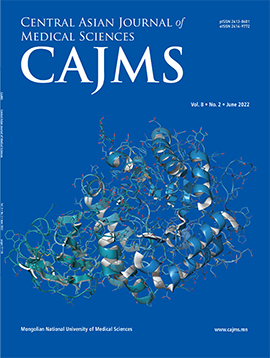The Aspects of Diagnosis and Treatment of Retinoblastoma in Mongolia
DOI:
https://doi.org/10.24079/cajms.2018.06.005Keywords:
Retinoblastoma, Chemotherapy/adjuvant, Laser therapy, MongoliaAbstract
Objectives: To describe the clinical characteristics and the treatment outcome of retinoblastoma in Mongolian children. Methods: Data of all children diagnosed with retinoblastoma at the National Center for Maternal and Child Health of Mongolia from 1987 to January 2017 were reviewed retrospectively. The ICRB classifi cation was used. Survival characteristics of the cohort were analyzed. Results: Retinoblastoma was diagnosed in 100 eyes of 79 children during the study period. Median age of diagnosis was 23.2±5.8 months. There were no differences in sex ratio and 21 cases (27%) were bilateral. Fifty-two patients (66%) were from rural areas. The more frequent clinical presentations were leukocoria in 64 (81%) patients, unilateral mydriasis 35 (45%) and strabismus in 34 (44 %) patients. Sixty-nine (87.3%) patients were diagnosed with Classifi cation D or worse when presented to us. Due to late diagnosis in the majority of cases, unilateral and bilateral enucleations were performed in 58 (58%) eyes and 26 (26%) eyes respectively; exenteration was done in 3 (3%) eyes, intravenous chemotherapy was done (11%) eyes and laser surgery was done (4%) eyes. After the mean follow up of 10 years, 67 (84.8%) patients were alive, 5 (6.3%) patients died and in 7 (8.8%) patients their vital status was unknown. The mean follow-up period was 144.1±16.3 (95% CI 122.6-165.5) months (range, 15-365months). In 5 cases in which immunohistochemistry analysis was performed, neuron-specifi c enolase (NSE), Ki-67 protein (Ki-67), B-cell lymphoma 2 (Bcl-2) positive cells were found in all of 5 (100%) cases and Rb protein was detected in 3 (60%) cases. Conclusion: The implementation of International Classifi cation of Retinoblastoma, systemic intravenous chemotherapy and laser treatment for retinoblastoma, shows favorable outcome in the treatment of retinoblastoma and further prognosis.
Downloads
152
Downloads
Published
How to Cite
Issue
Section
License
Copyright (c) 2018 Mongolian National University of Medical Sciences

This work is licensed under a Creative Commons Attribution-NonCommercial 4.0 International License.




